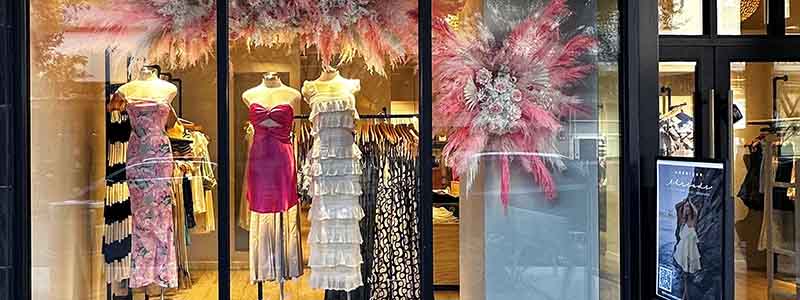

For small business owners, navigating between e-commerce platforms and brick-and-mortar storefronts isn’t just about sales — it’s about community, flexibility and adapting to how customers want to shop and pay. We spoke with three founders — Kaylee Koch of Texas Tushies, Anne Min of American Threads and Marianne Despres of El Sur — to explore the rewards and real-life challenges of building businesses that live both online and off.
From Facebook to downtown: Texas Tushies
Kaylee Koch started Texas Tushies out of necessity and new mom love. At 18, with her first baby and a tight budget, she turned to cloth diapers to save money. But when off-the-shelf options were causing absorbency and heat rash issues, she decided to create her own with a more absorbent athletic and jersey fabric, a standard now in the industry. What began as a personal solution evolved into a successful brand with bold, unique prints inspired by her Texas roots. “It was something I built for my son, and other parents started loving it, too,” she said.
Kaylee first launched the business through a Facebook group, eventually moving to an e-commerce platform. Demand exploded during the early months of the pandemic, when disposable diapers were hard to find, and cloth diapering provided a sustainable solution while helping to reduce the need to travel to stores.
As online orders rolled in, Kaylee saw a new opportunity: a physical space to house both a storefront and a warehouse. "The physical storefront was never really my financial in. It was a chance to build a community,” she recalled. Parents could come in, learn about cloth diapers and find unique baby gifts.
The storefront era brought its own lessons: managing employees, tracking additional bills like rent and utilities and balancing time away from her kids. Managing a cash drawer was added stress. “It’s 10 times easier to just manage card-only payments from a business aspect,” said Kaylee. “Cash was only 5 percent of our transactions. Our customers always wanted to pay by tapping with their digital wallets, especially busy moms who don’t want to juggle cash or cards.”


Though her primary sales remained online, the store became a local destination — and a way to demystify cloth diapering for new parents. She expanded her offerings after customers began asking for apparel and accessories featuring the same playful prints they loved in her diapers. But as her family grew, priorities shifted. With the birth of her third child in 2023, Kaylee made the tough call to close the storefront in early 2024.
“I miss it sometimes,” she admitted. “But closing it gave me the flexibility to focus on my kids and continue growing the business from home.” Today, Texas Tushies is thriving online, with plans to launch educational resources and brand collaborations for her growing social media following — all while her children play just steps away from their Texas Tushies warehouse, a large three-car garage at home.
Physical stores are the new billboard: American Threads
Unlike Texas Tushies, American Threads started offline — in a Georgia strip mall with free rent for the first six months and a vision. Anne Min, a former fashion wholesaler, opened her first retail store in 2008 during the recession, filling a style gap for young women in suburban Atlanta. “Back then, e-commerce wasn’t really as big of a thing,” she said. The largest department store was one hour away and she saw an opportunity to create a fashion-forward brand that would attract young women in the area.
Her early success came from bringing West Coast trends to the South and carrying popular shoe brands. As demand grew, she moved to a bustling lifestyle center and eventually expanded into eight stores across the Southeast. Then came the pandemic — and a pivot.
“We’d had an online presence five years in, but e-commerce didn’t become a forefront of our business until COVID,” she said. Orders poured in from across the country, and soon online sales surpassed her stores. Today, her team uses customer data from e-commerce sales to make smarter decisions — like opening a new location in Scottsdale, Arizona, after noticing a spike in online orders from the state.
Despite the e-commerce boom, Anne still believes in brick-and-mortar, but only when it makes sense. “We see physical stores more like billboard marketing,” she said. Her stores benefit from retail experiences and seasonal events — from game day to graduation season — and cater to Southern shoppers looking for the perfect outfit. “In the South, people dress for every occasion,” Anne said. “That’s how we compete with the big brands.”
When it comes to payments, she’s embraced digital. Most transactions, in-store and online, are contactless or via digital wallets. “At our Disney Springs store, we don’t accept cash at all,” she said. “Even where we do accept cash, the percentage of cash payments gets lower year over year.” And while she’s proud of how far the brand has come, Anne isn’t chasing mass expansion. “Success, to me, is dressing young women through all their milestones — from proms to graduations to weddings.”
On the road to restaurant life: El Sur
For Marianne Despres, founder of El Sur in Redwood City, California, the move from food truck to full-fledged café was driven by passion for her heritage. With roots in Argentina and Peru, she launched her business after attending the Cordon Bleu in Paris, serving handmade empanadas out of a 1970s Citroën truck she shipped from France.
“When we started, there weren’t many empanada options in the Bay Area,” she said. Her commitment to authenticity and quality helped El Sur gain a loyal following. “Having repeat customers is the most important thing,” she said. “It’s about having them come in, experience great food and service, and telling their friends. When the pandemic happened, our fans were the ones who kept us alive,” she added.


When the pandemic shut down foot traffic overnight, Marianne quickly launched an online store, selling frozen empanadas for delivery throughout the Bay Area. “Without digital payments, we wouldn’t have survived,” she said. Marianne set up online ordering within days, keeping her business alive during the hardest months. Even now, e-commerce remains a major part of El Sur’s operations, supplementing café sales and expanding her reach beyond Redwood City.
Today, El Sur’s restaurant is a neighborhood favorite, and the truck still makes appearances at private events. Payments, whether at the café, online, or via truck, are seamless. “We take credit cards, people tapping with their phones — whatever’s easiest for our customers,” said Marianne.
For her, success isn’t about rapid growth — it’s about feeding people good food and creating lasting connections. “When customers tell me our empanadas brought them comfort during the pandemic, it makes the sacrifice worth it.”
From clicks to what sticks
These three founders prove that success isn’t about choosing between online and in-person. It’s about understanding your customers, evolving with their habits and building a business model that works for your life.
Digital payments — from tap to wallet to e-commerce — are becoming standard. And whether it’s managing inventory from a garage, shipping dresses across the country or bringing homemade empanadas to the masses, the goal is the same: building something real, no matter where the transaction happens.